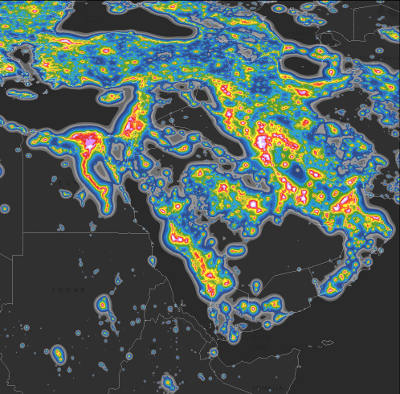Using AI to control energy for indoor agriculture
30 September 2024
Published online 26 June 2016
Shrouded in a haze of artificial light at night, not only do we lose the capacity to gaze at the stars but our health and the ecology suffer too.

© Falchi et al.
A new world atlas of artificial night sky brightness, published this month in Science Advances, captures the extent to which we are smothered in light. It reveals Kuwait, Qatar, United Arab Emirates and Saudi Arabia as the most light-polluted places to live on the planet, topped only by Singapore. More than half of people living in Israel and Libya live through extremely bright nights, and the widest connected twilight zone in the world is along the Nile Delta in Egypt.
No more can people in Kuwait and Qatar see the glowing band of the Milky Way from their homes. For more than 97 per cent of people in the United Arab Emirates, Israel, and Egypt, this is also true.
“The night sky is the beginning of our civilisation. It leads to all religions, philosophy, science, literature and the arts. The cultural significance of a sky full of stars is huge. The new generations have lost this source of inspiration,” says Fabio Falchi, of the Italian Light Pollution Science and Technology Institute’s Fabio Falchi, who led the study.
“People used to say that we live under an Arabic sky because the names of many stars are Arabic in origin. Now, light pollution doesn’t give people the access to the night sky our ancestors once had,” says Alaa Ibrahim, Professor of Astrophysics and Director of Observatory, Zewail City of Science and Technology in Egypt, who insists his students go the desert to experience the night sky.
More than losing a connection with the cosmos, scientists are concerned that overexposure to artificial light may be affecting our health and environment too.
“If we artificially change dark conditions, we confuse our biological clock and all the cells of our body by suppressing melatonin production,” says Abraham Haim, of the Israeli Center for Interdisciplinary Research in Chronobiology, University of Haifa.
Melatonin is important to the proper function of metabolic, thermoregulatory, immune, reproductive and other systems in the body. Disrupting clock function poses increased risks of breast cancer, prostate cancer, obesity and diabetes, Haim’s research shows.
Energy-saving short wavelength light emitting diodes (LEDs), which are increasingly used in public places and private homes, are the worst of all lights. Short wave light appears under natural conditions in the daytime, and its use at night, says Haim, is hazardous.
“We can show clearly that artificial light at night of short wave length illumination suppresses melatonin. It causes a decrease in global DNA methylation and the outcome is the proliferation of tumour cells.”
Such is the concern about the detrimental effects of LEDs that earlier this month the American Medical Association (AMA) adopted an official policy recommending communities in the United States dim this kind of street light. White LEDs, its statement says, have five times greater impact on circadian sleep rhythms than conventional street lamps. Large surveys in the US have shown brighter residential nighttime lighting is associated with reduced sleep times, dissatisfaction with sleep quality, excessive sleepiness, impaired daytime functioning and obesity.
Light pollution, says Falchi, is a consequence of the belief that artificial light improves road safety and reduces crime. Researchers increasingly say there is little evidence for this.
In fact, studies from the United Kingdom show that an attacker will use light to identify a victim, says Haim.
Evidence from Germany suggests lampposts on roads create additional pole hazards, says Falchi. The AMA notes that oversaturation of high intensity light on roads increases glare, and decreases visual acuity.
Further, there is the question of how artificial light affects non-human life on Earth. “The dark conditions required by some species might never happen and consequently they simply can’t persist,” says Travis Longcore, Adjunct Professor, University of California Los Angeles Institute of the Environment and Sustainability, and Science Director, The Urban Wildlands Group.
Light instructs orientation for many species. It also determines the foraging environment and affects the relationship between predators and prey.
Such considerations are particularly important in a desert environment where there is a greater proportion of nocturnal species adapted to darkness, with greater sensitivity to smaller shifts in light, such as desert spiders. Ecosystems that rely on lunar cycles to synchronise reproductive activities, like coral, will be undermined by light conditions that simulate a full moon, says Longcore.
In the Middle East, the first step towards decreasing light pollution is monitoring light use.
“We need to know the intensity thresholds we should not go above and remove short wave length illumination from public places,” says Haim, “There should be more regulation for how we behave with light. Street lights, windows in shops, billboards, should be shut down at a certain hour of the night, or be dimmed at least.”
Technological change, says Falchi, means LED light levels can be lowered and return to full power immediately. Moreover simple methods for shining light only when needed have been successfully tried and tested in Italy. “It works,” he says.
“It’s just good practice to turn the lights down,” says Ibrahim, “For very little effort you can make a high impact.”
doi:10.1038/nmiddleeast.2016.103
Stay connected: